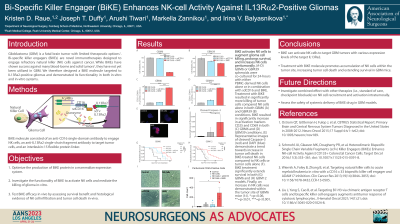Bi-specific Killer Engager (BiKE) Enhances NK-cell Activity Against IL13Rα2-Positive Gliomas
Bi-specific Killer Engager (BiKE) Enhances Nk-cell Activity Against il13rα2-positive Gliomas
Friday, April 21, 2023


Kristen D. Raue, BS
Medical Student
Rush Medical College
Chicago, Illinois, United States
ePoster Presenter(s)
Introduction: Glioblastoma is a fatal brain tumor with limited therapeutic options. Bi-specific killer engagers (BiKEs) are an immunotherapy designed to engage natural killer (NK) cells against cancer. We, therefore, designed a BiKE molecule against IL13Rα2, which is overexpressed in 60-80% of all glioblastoma tumors.
Methods: BiKE construct consisted of a single-domain antibody against CD16, an interleukin-15 linker, and a single-chain variable antibody against IL13Rα2. The protein was optimized for maximal production via lentiviral transduction of a HEK293 cell line, cell sorting, and various tissue culture conditions and purified via affinity chromatography of His-tagged BiKE protein. Production was assessed via Western Blot. An ELISA was used to assess its binding to IL13Rα2. PBMC-derived and expanded human NK cells with three different glioma spheroids (GBM6, GBM39, U87) were co-cultured to evaluate activation markers and cytotoxicity via flow cytometry. Glioma cell killing was verified via Caspase-3 immunofluorescence. An intratumor treatment of GBM6 xenograft-implanted Rag1-/- mice with NK cells and BiKE protein were used to assess survival benefit.
Results: BiKE protein was optimally produced at 32ºC and in DMEM media with 10% FBS. With both PBMC-derived NK cells and expanded human NK cells, BiKE protein resulted in increased NK cell activation through CD25+CD69+ surface markers (p < 0.01, n=4). BiKE increased glioma cell killing in all cell lines (GBM6, U87, and GBM39) measured by flow cytometry (p < 0.01, n=4) and verified via cleaved Caspase-3 immunostaining than glioma cells alone or NK-cell treated glioma cells. Finally, BiKE extends median survival in GBM6 mice (p < 0.01, n=8) compared to controls.
Conclusion : We demonstrate that our BiKE drug could be successfully produced in a mammalian expression system. The protein is functional in that it activates and augments NK cell killing of IL13Rα2-positive gliomas in-vitro and extends survival in a GBM6 mouse model.
Methods: BiKE construct consisted of a single-domain antibody against CD16, an interleukin-15 linker, and a single-chain variable antibody against IL13Rα2. The protein was optimized for maximal production via lentiviral transduction of a HEK293 cell line, cell sorting, and various tissue culture conditions and purified via affinity chromatography of His-tagged BiKE protein. Production was assessed via Western Blot. An ELISA was used to assess its binding to IL13Rα2. PBMC-derived and expanded human NK cells with three different glioma spheroids (GBM6, GBM39, U87) were co-cultured to evaluate activation markers and cytotoxicity via flow cytometry. Glioma cell killing was verified via Caspase-3 immunofluorescence. An intratumor treatment of GBM6 xenograft-implanted Rag1-/- mice with NK cells and BiKE protein were used to assess survival benefit.
Results: BiKE protein was optimally produced at 32ºC and in DMEM media with 10% FBS. With both PBMC-derived NK cells and expanded human NK cells, BiKE protein resulted in increased NK cell activation through CD25+CD69+ surface markers (p < 0.01, n=4). BiKE increased glioma cell killing in all cell lines (GBM6, U87, and GBM39) measured by flow cytometry (p < 0.01, n=4) and verified via cleaved Caspase-3 immunostaining than glioma cells alone or NK-cell treated glioma cells. Finally, BiKE extends median survival in GBM6 mice (p < 0.01, n=8) compared to controls.
Conclusion : We demonstrate that our BiKE drug could be successfully produced in a mammalian expression system. The protein is functional in that it activates and augments NK cell killing of IL13Rα2-positive gliomas in-vitro and extends survival in a GBM6 mouse model.
